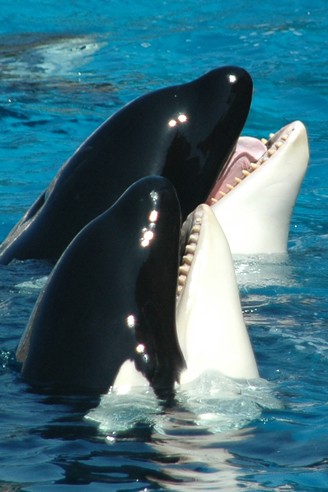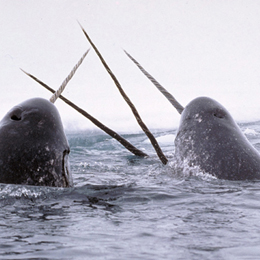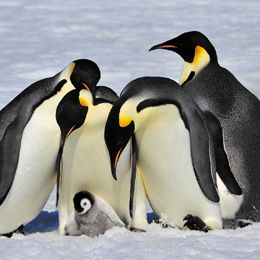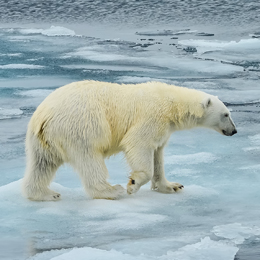Physical Description
The Killer whale or the Orca got its name because of being a natural predator that hunts whale species in the ocean waters. This species is an apex predator that usually swims in family groups (pods) and lacks natural enemies in the wild. Orcas possess large dorsal fins that are present in the middle of a long rounded body. The sleek black body of an Orca consists of a white toned belly and easily distinguishable white patches near the eye. The streamlined shape, large size and conical shaped head of a Killer whale make it among the fastest marine mammals. They are commonly found foraging in coastal, intertidal flats.
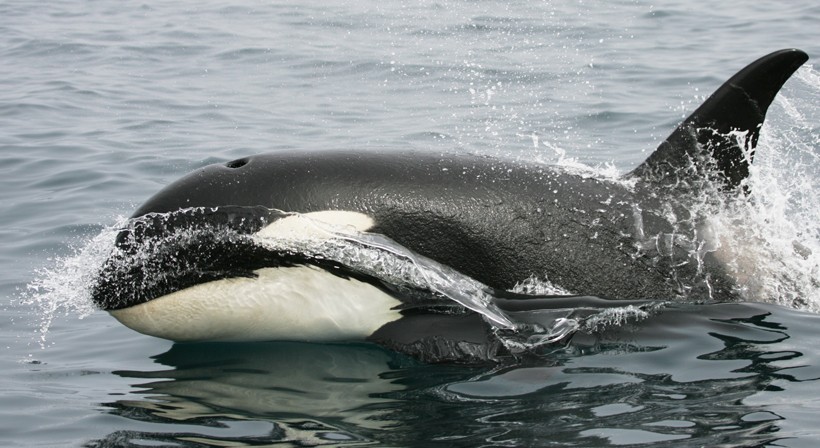
The coloration of the killer whales is counter-shaded: the dark top and light colored belly is a natural camouflage in water.
?
Image credits: Tatiana Ivkovich/Shutterstock
While male orcas can reach an approximate length of 6 – 8 meters (20 – 26 ft), females are slightly smaller reaching a total length of 5 – 7 meters (16 – 25 ft). The average weight of an adult Killer whale is around 3000 – 5000 kg. The largest male ever found measured 32 feet with an overall weight of over 9000 kg while the largest female Orca recorded was 28 feet and weighed 6800 kg. The average lifespan of Killer whales differs in terms of gender where females show higher life expectancy compared to males. While male orcas live up to 30 – 40 years in the wild, female orcas possess a life expectancy of 60 years or even more.
Habitat
Orcas are broadly distributed in all oceanic habitats (marine) worldwide with a total population that is estimated being more than 50,000 individuals. Killer whales rarely swim into freshwater rivers, and therefore, are found mostly in saltwater bodies. They clearly prefer high latitudes and coastal habitats over a pelagic environment. They have an amazing potential to endure extremely chilled temperatures and can also be part of a tropical ecosystem.
Killer whales are mostly concentrated in low-temperature zones including the Northwest Atlantic, Northwest Pacific, Antarctic and the Indian Ocean where there is an abundant catch. Different subspecies occupy their own unique home range but this species is also known to migrate seasonally. Killer whales generally visit shorelines or shallow waters in search for food and can dive up to 300 meters although they prefer a range depth of 20-60 meters. Killer whales also visit the Arctic waters during the winter season but tend to evade pack ice during summers.
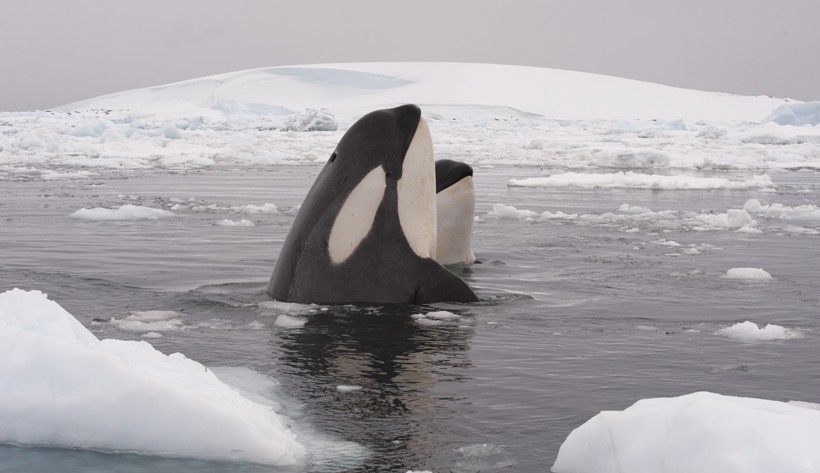
Mother with calf, antactica
?
Image credits: vladsilver/Shutterstock
Depending upon habitat, feeding habits and anatomical features Killer whales are specified into 10 recognized ecotypes
- In the North Pacific Ocean
- Resident
- Transient (Bigg’s)
- Offshore
- In the Atlantic Ocean
- Type 1
- Type 2
- In the Antarctic Ocean
- Type A
- Type B
- large
- small
- Type C
- Type D
- Resident
- Transient (Bigg’s)
- Offshore
- Type 1
- Type 2
- Type A
- Type B
- large
- small
- Type C
- Type D
Distribution of Ecotypes
Killer whales are highly productive in cold or temperate waters occupying areas of high latitudes. This species prefers swimming in coastal waters and can be found in all the oceans around the world. Orcas assigned to a particular ecotype inhabit a unique location and showcase morphological features that are slightly different from the rest.
North Pacific Ocean
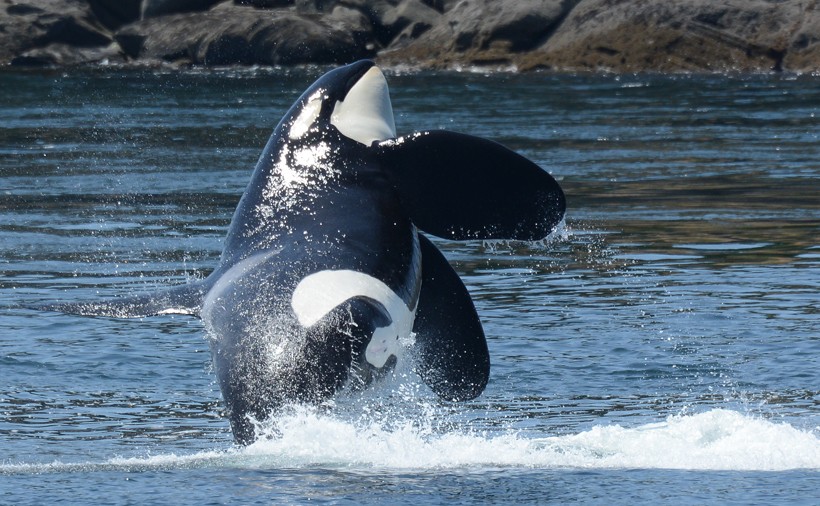
Southern Resident killer whale male
?
Image credits: Sara Hysong-Shimazu/Shutterstock
- Resident
The most commonly sighted Orcas are the Resident types in the coastal waters of the eastern half of the North Pacific Ocean. They are known as residents because they visit the same areas consistently with little change to their home range. The resident orcas move in cohesive and complex family groups. They typically travel in groups of 10-80 individuals that are morphologically distinguishable by the presence of a rounded dorsal fin tip and open saddle patches with a black pigment that breaks apart the grayish-white saddle patch. Resident orcas generally consume 45 – 135 kg food a day preying primarily on cod, salmon and herring. They also use a unique vocal dialect that transfers important information regarding maternal genealogy, feeding grounds and breeding.
Three distinct populations fall under the Resident ecotype: The Alaskan resident group is the largest pod that maintains a size of 500+ individuals. The Northern resident group swims in the inland waters of Vancouver Island and through the Johnstone Strait comprising of 250+ individuals. The smallest resident group is the Southern resident pod that visits the shores of Washington and southern British Columbia. Their diet primarily consists of the Chinook salmon. Their population is currently on a decline. Therefore, the Southern residents have become a major source of study and conservation under the Orca Survey Project.
The most commonly sighted Orcas are the Resident types in the coastal waters of the eastern half of the North Pacific Ocean. They are known as residents because they visit the same areas consistently with little change to their home range. The resident orcas move in cohesive and complex family groups. They typically travel in groups of 10-80 individuals that are morphologically distinguishable by the presence of a rounded dorsal fin tip and open saddle patches with a black pigment that breaks apart the grayish-white saddle patch. Resident orcas generally consume 45 – 135 kg food a day preying primarily on cod, salmon and herring. They also use a unique vocal dialect that transfers important information regarding maternal genealogy, feeding grounds and breeding.
Three distinct populations fall under the Resident ecotype: The Alaskan resident group is the largest pod that maintains a size of 500+ individuals. The Northern resident group swims in the inland waters of Vancouver Island and through the Johnstone Strait comprising of 250+ individuals. The smallest resident group is the Southern resident pod that visits the shores of Washington and southern British Columbia. Their diet primarily consists of the Chinook salmon. Their population is currently on a decline. Therefore, the Southern residents have become a major source of study and conservation under the Orca Survey Project.
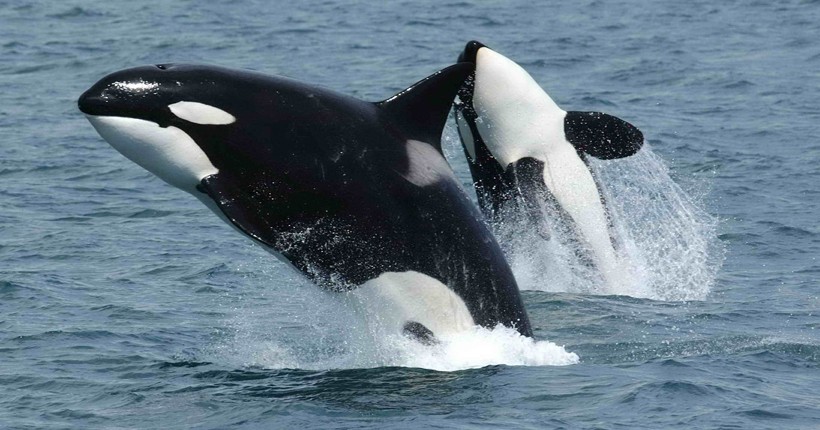
Transient killer whale
?
Image credits: Public Domain
- Transient
Transient orcas, popularly known as Bigg’s Killer whale in honor of Michael Bigg, roam the coasts of southern Alaska and California. They exclusively feed on marine mammals like the California sea lions, harbor seals, porpoises, sea otters and traveling in small groups that consist of two to five individuals. They use little vocalization and generally tend to avoid cross breeding with resident orcas. Transient orcas are characterized by the presence of triangular and pointed dorsal fins with a uniform gray coloring that persists on their saddle patch.
- Offshore
The third population of north Pacific orcas consists of the offshore killer whales that are rarely seen and swim away from the shoreline. They primarily feed on schooling fish like salmon, halibut, although evidence suggests that they also consume Pacific sleeper sharks. They are often encountered away from the west coast of Vancouver Island and near the Queen Charlotte Islands. They congregate in groups of 25-75 individuals and are easily distinguishable by their large, nicked and scarred dorsal fins and rounded fin tips.
North Atlantic Ocean
- Type 1
This particular subspecies of Orcas showcase a varied diet that consists of both schooling fish like herring and marine mammals like seals. Type 1 is a smaller subspecies that feeds on mackerel and herring off the coast of Sweden, Norway, and Iceland. Observations conclude that Type 1 orcas are specialized subspecies that showcase resident-like social structures.
- Type 2
Primarily found in Argentina and Crozet Islands, Type 2 exclusively feeds on marine mammals or cetacean species like baleen whales, dolphins, porpoises etc. This particular type of killer whale showcases a transient-like social structure that has also been spotted off the west coast of Ireland and Scotland.
Antarctic Ocean
- Type A
Typically transient ecotype predators, Type ‘A’ killer whales are circumpolar that swim in the open waters or outside pack ice throughout the Antarctic continent. They primarily feed on Minke whales and showcase a robust body with a medium sized eye patch that runs parallel with the body axis.
- Type B
Type ‘B’ orcas consist of two sub ecotypes: large and small; however both are smaller as compared to Type ‘A’ orcas with a larger eye patch. Their bodies are more gray than black and have a dark gray dorsal cape which is the most distinguishing feature. Their bodies are generally covered in diatoms that give off a whitish/yellowish pigment. The larger type B’s are popularly known as ‘Pack Ice Killers’ of the Antarctic because they hunt for Weddell seals in cooperative packs. The smaller type B’s are known as Gerlache killer whales because they inhabit the waters of the Gerlache Strait. They are smaller in size with a slightly tilted eye patch and are known for hunting penguins away from pack ice.
- Type C
Commonly referred to as ‘Ross Sea’ killer whale, this particular subspecies is quite similar to type B’s with a narrow eye patch that is tilted forward about 45 degrees. They are the smallest orcas known with a body length of 6 meters (20 ft). Type C orcas only inhabit inshore waters of the eastern Antarctic, feeding primarily on the Antarctic toothfish.
- Type D
Also known as sub-Antarctic orca, Type ‘D’ orca is the newest subspecies that has been genetically identified and added to the collection. The bulbous head, tiny eye patch and short dorsal fins are distinguishing characteristics of this subspecies that typically feeds on fish like the Patagonian toothfish and Chilean sea bass.
Transient orcas, popularly known as Bigg’s Killer whale in honor of Michael Bigg, roam the coasts of southern Alaska and California. They exclusively feed on marine mammals like the California sea lions, harbor seals, porpoises, sea otters and traveling in small groups that consist of two to five individuals. They use little vocalization and generally tend to avoid cross breeding with resident orcas. Transient orcas are characterized by the presence of triangular and pointed dorsal fins with a uniform gray coloring that persists on their saddle patch.
The third population of north Pacific orcas consists of the offshore killer whales that are rarely seen and swim away from the shoreline. They primarily feed on schooling fish like salmon, halibut, although evidence suggests that they also consume Pacific sleeper sharks. They are often encountered away from the west coast of Vancouver Island and near the Queen Charlotte Islands. They congregate in groups of 25-75 individuals and are easily distinguishable by their large, nicked and scarred dorsal fins and rounded fin tips.
This particular subspecies of Orcas showcase a varied diet that consists of both schooling fish like herring and marine mammals like seals. Type 1 is a smaller subspecies that feeds on mackerel and herring off the coast of Sweden, Norway, and Iceland. Observations conclude that Type 1 orcas are specialized subspecies that showcase resident-like social structures.
Primarily found in Argentina and Crozet Islands, Type 2 exclusively feeds on marine mammals or cetacean species like baleen whales, dolphins, porpoises etc. This particular type of killer whale showcases a transient-like social structure that has also been spotted off the west coast of Ireland and Scotland.
Typically transient ecotype predators, Type ‘A’ killer whales are circumpolar that swim in the open waters or outside pack ice throughout the Antarctic continent. They primarily feed on Minke whales and showcase a robust body with a medium sized eye patch that runs parallel with the body axis.
Type ‘B’ orcas consist of two sub ecotypes: large and small; however both are smaller as compared to Type ‘A’ orcas with a larger eye patch. Their bodies are more gray than black and have a dark gray dorsal cape which is the most distinguishing feature. Their bodies are generally covered in diatoms that give off a whitish/yellowish pigment. The larger type B’s are popularly known as ‘Pack Ice Killers’ of the Antarctic because they hunt for Weddell seals in cooperative packs. The smaller type B’s are known as Gerlache killer whales because they inhabit the waters of the Gerlache Strait. They are smaller in size with a slightly tilted eye patch and are known for hunting penguins away from pack ice.
Commonly referred to as ‘Ross Sea’ killer whale, this particular subspecies is quite similar to type B’s with a narrow eye patch that is tilted forward about 45 degrees. They are the smallest orcas known with a body length of 6 meters (20 ft). Type C orcas only inhabit inshore waters of the eastern Antarctic, feeding primarily on the Antarctic toothfish.
Also known as sub-Antarctic orca, Type ‘D’ orca is the newest subspecies that has been genetically identified and added to the collection. The bulbous head, tiny eye patch and short dorsal fins are distinguishing characteristics of this subspecies that typically feeds on fish like the Patagonian toothfish and Chilean sea bass.
Migration
Killer whales are highly social animals that particularly prefer cold temperature although they can occur also at lower densities in offshore, temperate and sub-tropical waters. The migratory movement of Orcas depends upon a range of factors like migratory shoals or climatic conditions. Orcas generally migrate wherever their food source is, like for example the North Pacific killer whale that moves parallel to salmon migrations. The North Atlantic killer whales follow the movements of Herring in Norwegian and Icelandic waters.
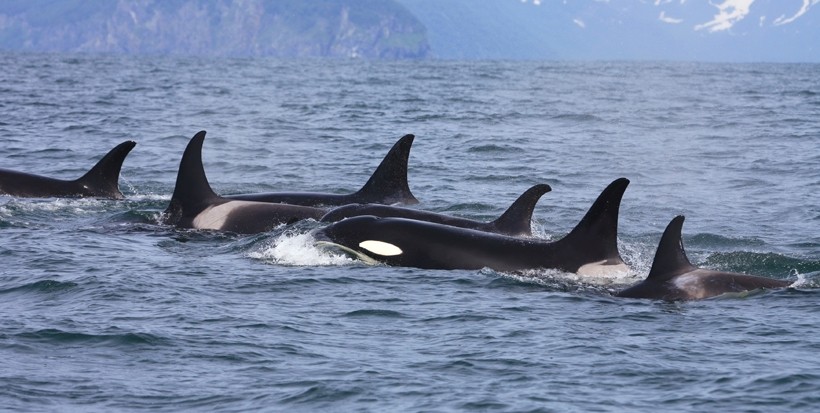
Killer whale group traveling
?
Image credits: Tatiana Ivkovich/Shutterstock
Type A killer whales enter Antarctic waters during the summer season while Type B orcas migrate from Antarctic region to the subtropical waters of Brazil and Uruguay. The Antarctic killer whales migrate towards warm waters to evade heavy ice formations in the Arctic waters.
Anatomy
Orcas are very distinctive in appearance with a striking black coloring, a conical shaped head and a small beak that consists of 10 – 13 conical teeth on the lower and upper jaw. The dorsal surface is dark black with a white patch extending from the bottom of the chin to the anus on the ventral surface. They also have a white ‘eye spot’ that lies behind and above each eye. Orcas display a saddle patch which is basically a grey spot behind the dorsal fin on the back. The distinctive coloration of killer whales ensures the predator is counter-shaded: the dark dorsal (top) surface when viewed from above and the light colored belly when viewed from below is a natural camouflage in water. The fusiform shape of an orca enables it to swim efficiently in water since it reduces drag. The killer whale possesses glands located at the inner corners of the eye sockets that secrete an oily, mucous-like substance for lubricating the eye.
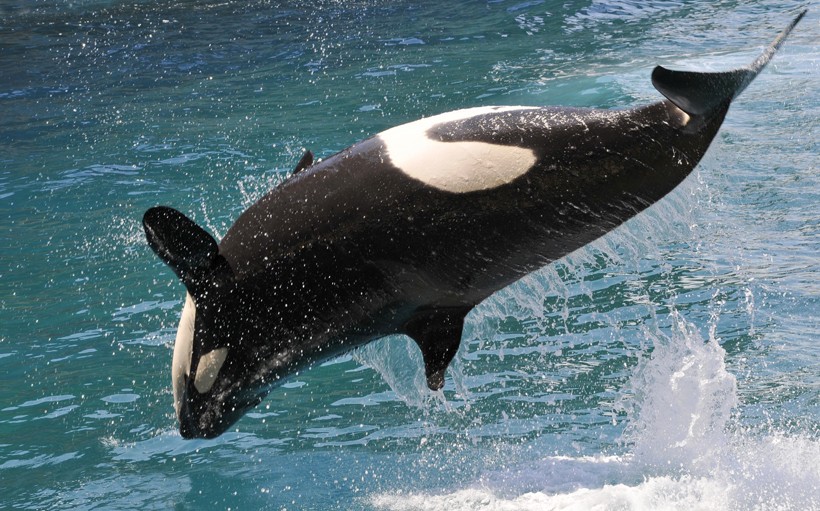
The two lobed tail of the orca typically measures 2.75 meters (9 ft) from tip to tip
?
Image credits: Christian Musat/Shutterstock
While the Antarctic type A killer whales are the largest known, not yet rated, subspecies reaching an approximate length of 9,1 m (30 ft), the smallest is the Antarctic type C that shows a maximum length of 5,5 m (18 ft). They also possess a layer of insulating blubber under the skin which is 7.6 – 10 cm thick. They have paddle-shaped pectoral fins and a distinct dorsal fin that varies in shape and size. The vertical dorsal fin measures 1.8 meters in case of male adult orcas whereas for juveniles and females the height of the dorsal fin is only 0.9 meters. In order to maintain body temperature, the pectoral flippers are physically adapted to regulate blood circulation. Tail flukes or the two-lobed tail of an orca typically measures 2.75 meters (9 ft) from tip to tip. A killer whale breathes through its blowhole that is covered by a muscular flap. Killer whales are known to have the ability to control the flow of blood to their brain and heart which helps them to dive deep underwater while surviving a relatively long period without oxygen.
Prey
Killer whales are extremely intelligent marine mammals that tactfully lure and attack their prey using a number of senses. They possess a well-developed sense of hearing underwater that helps process sounds at a high speed using their echolocation abilities. The bone and soft tissue transfer the sound waves to the killer whale’s middle and inner ears. They usually cruise at a speed of 13 km/h but are capable of bursting at a faster speed of up to 45 km/h which makes them agile predators. Resident killer whales don’t feed on marine mammals, however, they do harass and kill porpoises for a reason yet undiscovered.
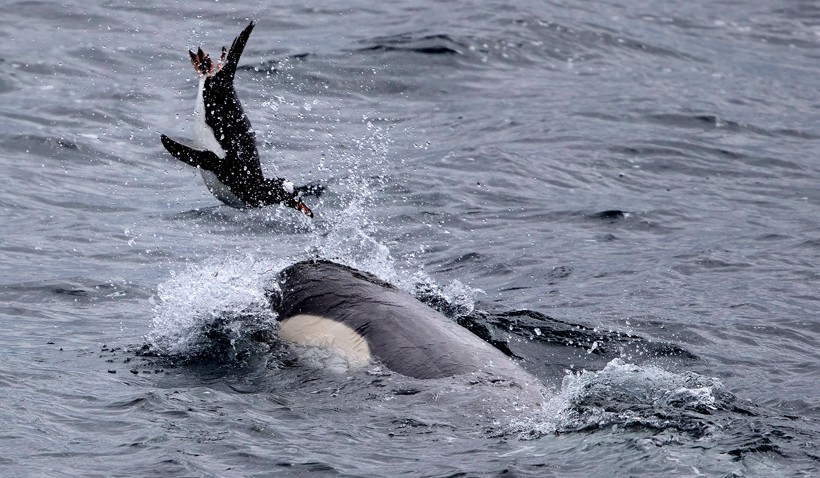
Killer whale playing with penguin
?
Image credits: Stephen Lew/Shutterstock
They have an extremely diverse diet that consists of fish, invertebrates, mollusks and marine mammals. They prey on more than 140 species of marine creatures including sharks, bony fish, herring, halibut, mackerel, antarctic toothfish, Chilean seabass and rays (batoid's). They also eat leatherback sea turtles, sea lions, seals, penguins and porpoises.
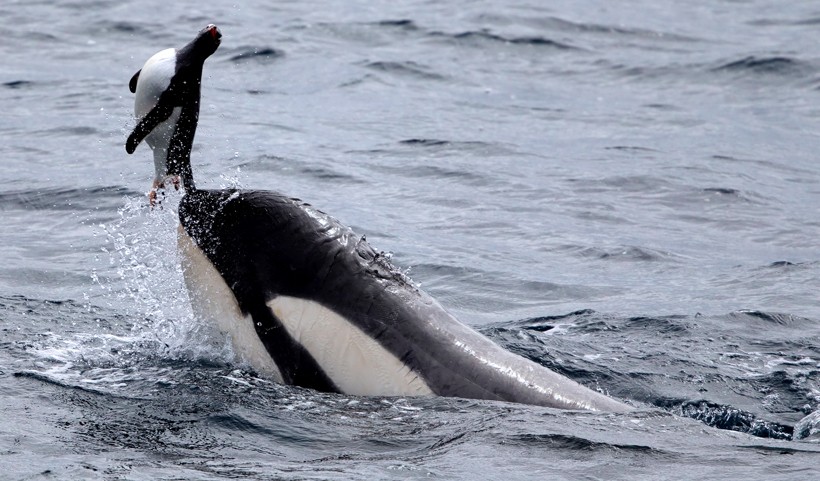
Killer whale catching a gentoo penguin
?
Image credits: Stephen Lew/Shutterstock
They usually hunt in packs by surrounding their prey before attacking. Orcas don’t chew their food. Instead, they either swallow their prey whole or shred it to pieces. Killer whales may regurgitate fish onto a surface to attract seagulls or cormorants that are caught and consumed by the species.
Reproduction Cycle
Killer whales possess amazing parenting skills especially since they follow a distinct social hierarchy. Their mating is polygynandrous which means both male and female have multiple mates in a lifetime or throughout a season. The mating season usually takes place during the summer months although it has been observed that a female can enter estrus multiple times in a year. To avoid inbreeding, males generally breed with females from another pod once a female reaches sexual maturity, that is between 6 to 10 years. The gestation period can occur for 15 to 18 months and the birth of a calf takes place during the fall. Adult killer whales give birth to a single calf once in 3 to 10 years. The newborn calf is nursed its whole weaning period which ended in between 12 – 24 months after birth.
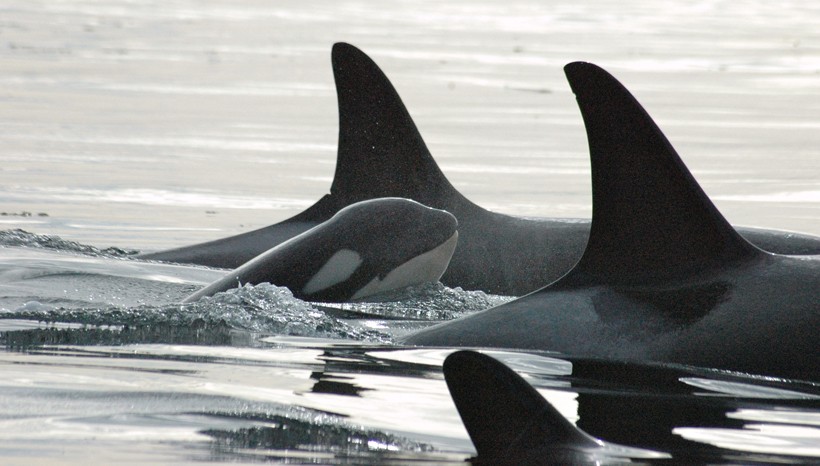
Killer whale calf surrounded by family
?
Image credits: Monika Wieland/Shutterstock
Females are capable of breeding until they reach an age of 40 years. Thereafter fertility is declining rapidly. Newborn calves are 2.6 meters (8.5 ft) long and weigh about 120-160 kg (265-350 lbs). Baby killer whales feed on milk that is rich in fats. High-fat milk is a physical adaptation that ensures young calves to build quickly the thick insulating blubber.
Calves feed for 5 – 10 seconds several times an hour, every day. They are nursed below water, close to the surface where the mother glides in a horizontal position arching her tail for her newborn calf. During the first year, most calves reach an approximate weight of 400 kg (880 lbs). The first vocalization of a young calf is known as a ‘scream’ that is a form of call out to its mother.
Behavior
Killer whales showcase a complex social system that is matrilineal. This means that a group of killer whales is connected by maternal descent like a mother traveling with a son and a daughter that can also include the offspring of the daughter. The group may contain up to four generations of killer whales. A pod is the next social structural unit that contains 1 - 4 related matrilines traveling together. Clans are formed by a combination of several pods are distinguished on the basis of different vocal dialects. They can overlap often certain geographic areas so it isn’t unusual to see several pods of different clans traveling together. The top level of social structure is known as the community that isn’t based on maternal links or vocal dialects but is a group of killer whales that have a common home range. Killer whale pods contain hunters, pregnant females, calves and juvenile males that migrate together.
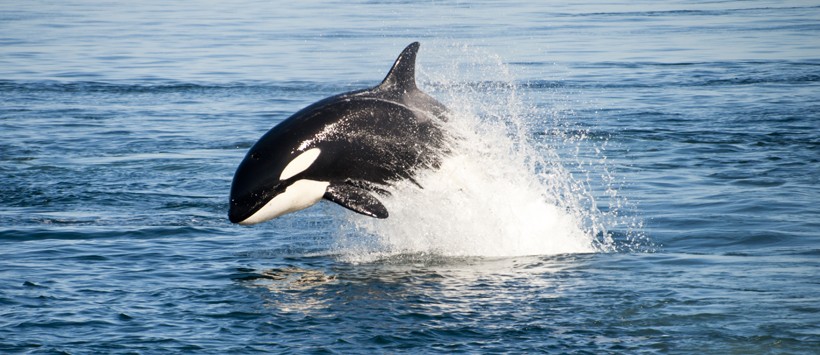
Killer whale breaching the water
?
Image credits: qingqing/Shutterstock
The social hierarchy that exists within a group of killer whales shows female dominance although male within a pod can rank themselves by establishing dominance over the alpha female using certain gestures. Head butting, slapping their tails against the water, tooth-scratching, biting and jaw snapping are common gestures to attain dominance in a pod. It has been observed that calves are greatly influenced by their mothers from whom they receive social discipline in the form of raking (tooth-scratching) and controlling the calf’s movements. Resident and transient pods don’t interact while traveling in the same geographical area. These intelligent creatures showcase a unique habit of scanning their surroundings by raising their heads at an angle that originates from a horizontal position.
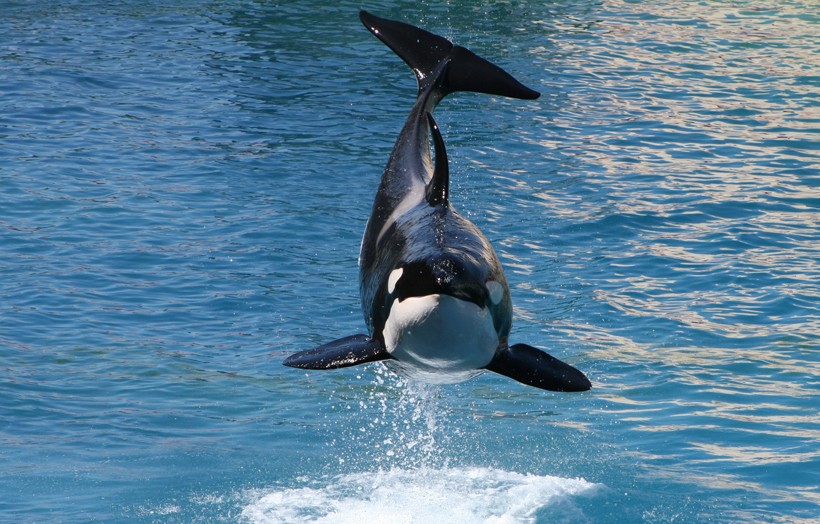
Killer whale jumping out of the water
?
Image credits: Ferderic B/Shutterstock
Killer whales often ‘burp’ which is an above-surface vocalization that sounds like letting out gas. They are known to be quick chasers by making sudden movements or lunges while seeking prey. Orcas also use a certain tactic known as ‘circling’. These circling movements are used while chasing a prey. Logging, which is technically a form of resting, is a behavior where orcas rest at the water surface, exposing only the melon, part of the dorsal fin and the upper back for a period of minimal ten seconds. Porpoising is a behavior characteristic to the dolphin family, in which the orca travels at high speed and the majority of its body breaks the surface creating a ‘V’ shaped spray on the side of their body.
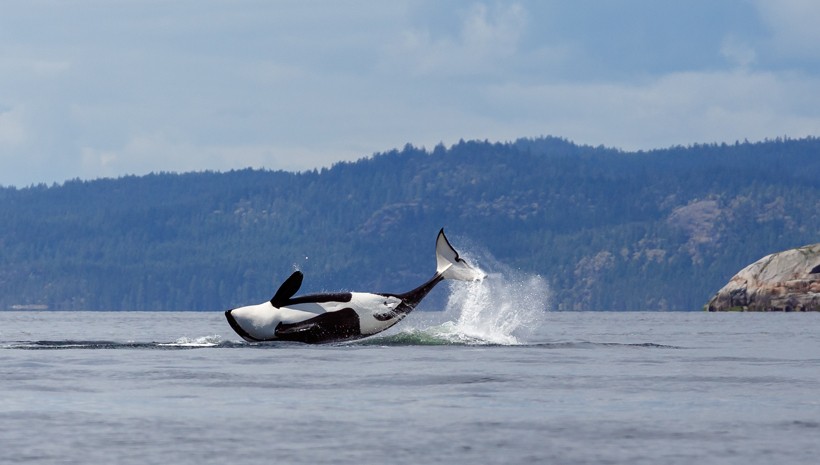
Killer whale making a turn while breaching
?
Image credits: Menno Schaefer/Shutterstock
Other commonly observed whale behaviors are:- Lob-tailing: A behavior in which the Orca flaps the tail flukes on the surface of the water to create loud sounds.
- Spyhop: A behavior in which the Orca rises out of the water vertically by exposing part of its head.
- Breach: A behavior in which the Orca powerfully thrusts two third of its body out of the water and lands on the surface on its back with a splash.
- Rubbing beaches: A behavior in which the Orca rubs its body along pebbly or rough bottoms along shallow bays to remove dry skin.
- Kelping: A behavior in which the Orca plays with ‘kelp’ or seaweed by dragging a part of the plant on any body part which is usually the notch of its flukes.
- Tail thrashing: A behavior in which the Orca indicates its pursuit of a prey by thrashing a tail fluke through the water surface.
Communication
Orcas depend upon sound production and reception for navigation, foraging and communication. They produce sounds using echolocation which can be in the form of whistles, clicks, screams, pulsed calls, low-frequency pops and jaw claps. The sound is produced by the moving air between the nasal sacs located in the blowhole region.
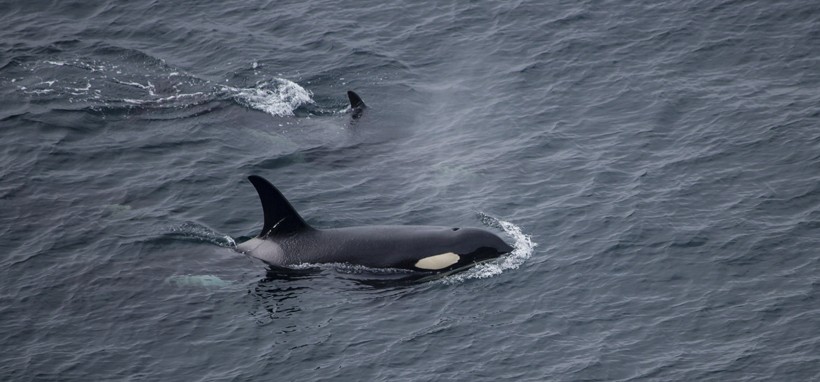
Whisles are used for close-range communication
?
Image credits: nbiebach/Shutterstock
Whistles are high-pitched sounds for close-range or private communication within a pod. It can also be used for the coordination of behavioral interactions between animals. Pulsed calls are also a common vocalization used by orcas. Pulsed calls are a form of recognition in a group and used for coordination of behavior. Pulsed calls are generated in a frequency of 0.5 to 25 kHz. Stereotyped calls or a ‘dialect’ is unique for every pod that helps orcas to associate with one another in a clan. Killer whales may also showcase aggressive behavior through gestures like jaw snapping, head butting and breaching.
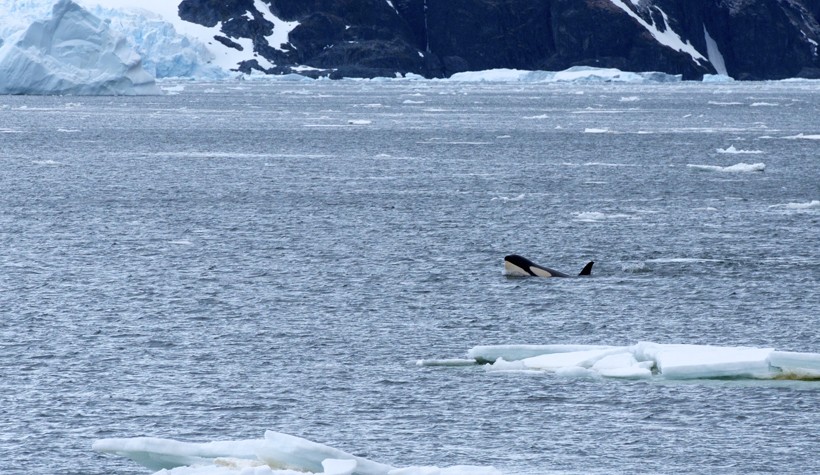
Pulsed calls are used for coordination in a pod
?
Image credits: Arturo de Frias/Shutterstock
Echolocation by orcas takes place by producing a sound known as ‘clicks’ which is received and interpreted through a resulting echo. Orcas use their phonic lips to produce broadband clicks in a progressive succession which lasts less than a millisecond. The clicks pass through the melon (rounded region of an orca’s forehead) which acts as an acoustic lens that focuses the sound waves into a directional beam and projects it into the water. Once the sound waves hit or bounce off objects, they are projected back to the killer whale that perceives this wave using fat filled cavities located in the lower jaw bone. Echolocation is important since it helps orcas to determine the size, shape, speed, composition, direction and structure of an object.
Conservation
The Southern residents of the North Pacific Ocean are ESA Endangered (since 2005) but the remaining ecotypes haven’t been listed as of date. According to the MMPA, the Atlantic Type 1 orcas have been assigned the status ‘Depleted’. All ecotypes of the Killer whale species have been listed in the CITES Appendix II. Transient and offshore killer whales are usually difficult to catch and observe with a maximal challenge for the resident ecotype.
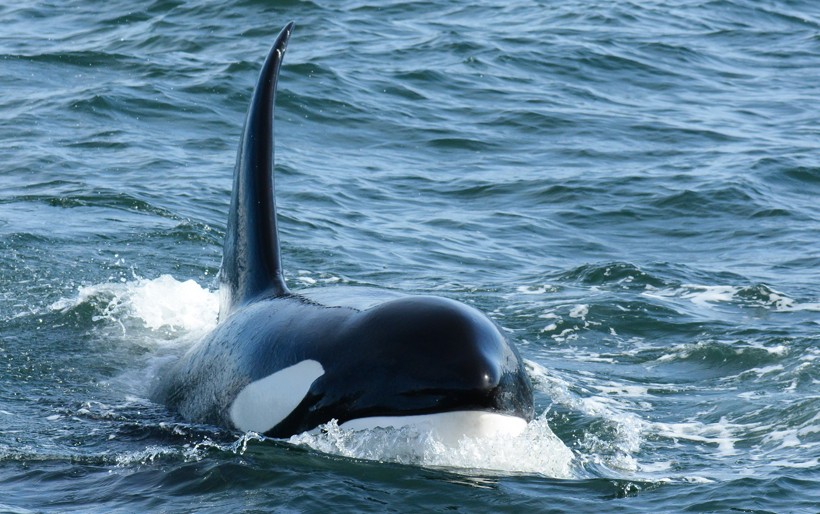
Closeup endangered southern resident killer whale
?
Image credits: Sara Hysong-Shimazu/Shutterstock
The Center for Whale Research is working on scheduled projects to preserve the habitat and population density of the Southern residents in the Pacific Ocean. Local estimates conclude that the Antarctic population is roughly 25,000. 8500 orcas are estimated in the tropical waters of the Pacific Ocean, 1500 off Norway and 2500 in the cool waters of northeast Pacific.
Funfacts
- Orcas can eat up to 5% of their body weight each day resulting in an average of 500 pounds of food.
- A Killer whale’s pectoral flipper contains five digits, which is quite similar to a human hand.
- When a Killer whale reaches surface its heartbeat is 60 beats per minute, but this rate drops to 30 beats per minute while diving underwater.
- According to research, Killer whales often stun their prey using their tail fluke right after herding.
- Carousal feeding of Herring takes place once orcas push the school of fish into a tight ball using their flashy white undersides or by producing bubbles
- When all three (worldpopulation is divided in 3 pods) southern resident pods (named J, K, L) travel together, they are referred to as the ‘Sugar Pod’.
- A killer whale calf swims close to its mother and in her slipstream which is a hydrodynamic wave produced while the mother swims.
- The oldest known female orca is Granny with an estimated age of 103 years.
- The deepest dive of a killer whale recorded has been 259 meters (850 ft) performed under experimental conditions.
